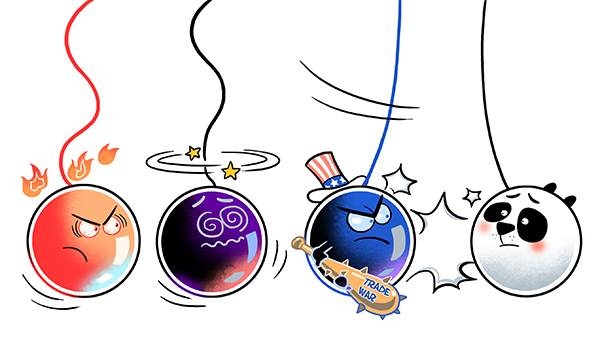Light can be seen at the end even if tunnel is bleak


One year after the United States launched the trade war against China, not only have Sino-US relations deteriorated but also the perceptions of the two peoples about each other have changed, which is something that could have been avoided.
A Pew Research Center public opinion survey titled "US views of China turn sharply negative amid trade tensions", released on Aug 13, shows a historic drop in Americans' favorable view of China, and provides ample food for thought and for action.
Since Pew started surveying US citizens' attitudes toward China in 2005, the share of Americans who have an unfavorable view of China this year is at an all-time high of 60 percent, up from 47 percent last year. The percentage with a favorable view of China dropped from 38 to 26.
Also, an increasing number of Americans regard China as a threat. Twenty-four percent name China as the country or group which could pose the greatest threat to the US in the future, twice as many as those in 2007.
The percentage of Americans who see current Sino-US economic ties as bad is 53 percent, with only 41 percent saying they were good. One of the starkest statistics concerned China's growing military might, with 81 percent of Americans saying it is a bad thing and a mere 11 percent saying it's a good thing.
There is a partisan divide as well. Among Republicans (or those who lean toward the Republican Party), 70 percent have a negative view of China, up 19 percent from last year, while among Democrats (or those who lean toward the Democratic Party), it is 59 percent, an increase of 12 percent from last year.
Every cloud has a silver lining, though, and the Pew survey is no exception. Half the Pew respondents said China's growing economy is a good thing, while 41 percent said it's a bad thing. And younger respondents had a more favorable view of China than their older counterparts.
To be fair, the trade war is only one major battleground among several coordinated elements that appear designed to stop China's rise and a corollary of the US administration's zero-sum "America-first", everyone-else-last orientation. The US administration's strategy statements such as the 2017 US National Security Strategy, the 2018 Summary of the National Defense Strategy, and the US "Free and Open Indo-Pacific Strategy" form another element which explicitly label China as a fundamental, existential threat to Western interests.
Still another element is US Vice-President Mike Pence's vicious and inaccurate attack on China-at the Hudson Institute last October. All these and more have combined to lead to the results seen in the Pew research.
There may, however, be reason for some optimism. With the recent stock and bond market gyrations driven by evidence of slowing economies in the US, China, Germany and elsewhere, it seems that in recent days both sides have seen the writing on the wall and may be more ready to make a deal.
So what is to be done? How can the two sides begin to lower the temperature and step back from the precipice? While the two major powers are destined to be "frenemies", how can we put the emphasis on the "friends" part of the equation?
One way is to undertake confidence-building measures that are win-win. In 2008, China and the US began negotiations for a "Bilateral Investment Treaty", an agreement which typically would contain provisions to provide reciprocal investment protections and encourage bilateral commercial ties.
In 2013, China agreed to negotiate a "high standard" BIT which would include opening up new sectors to foreign direct investment (FDI) and generally not discriminate against US companies invested in China, and vice versa. The two countries were unable to reach an agreement by the end of 2016, and after assuming office in 2017 the new US leader put the BIT on the back burner. Many experts believe a BIT could significantly boost bilateral FDI and trade flows.
Back in 2013, China and the European Union began negotiating a BIT-like agreement and are on track to conclude it next year. Which is good news, but to address the US administration's maniacal fixation on trade, the way trade deficits are calculated needs to be brought to 21st century standards by adopting the value-added approach. For example, China adds $8.50 in value to an iPhone, which incidentally is recorded as a $240 Chinese import.
Additionally, the fast growing services sector needs to be added to the mix with goods. The US administration conveniently forgets to mention that the US has a trade surplus with China in services that reduces the overall deficit.
Indeed, it's high time to analyze the workings of the World Trade Organization and other multilateral institutions to raise their standards to this century's level and to give countries such as China and India more voice in such forums.
Hopefully, one day, China and the US will get back to President Xi Jinping's concept of a new type of major-country relationship which he began with former US president Barack Obama, and which helped finalize the Paris climate accord but which was stopped cold by the incumbent US administration.
While things look rather bleak now as reflected by the Pew data, as an optimist, I can see light at the end of the tunnel.
The author is a senior fellow of the think tank Center for China and Globalization. The views don't necessarily reflect those of China Daily.


































